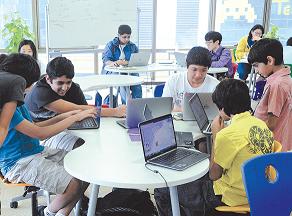The recent buzz around the world about the changing methodology in education revolves around the concept of the flipped classroom. Teachers are using technology to connect with their students and help them learn. In a traditional classroom, the teacher is the ‘sage on the stage,’ who uses the textbook, explains the ‘lesson’ and the difficult words, asks questions to test understanding, and sets homework. Students rarely ask questions. Whatever the pace or learning–style of the individual learner, the teacher does the teaching in the ‘one size fits all’ mode. Students listen passively and keep processing information as the teacher teaches. They absorb all that they can, and sometimes miss chunks. There is no time to reflect or think actively.
In flipped–teaching, the teacher records her teaching in a video. This video is shared among the students. They learn individually, each at his or her own pace.
As a student, I can fast–forward or rewind parts which I know or need to know better. Psychologically, I don’t feel at a disadvantage if I don’t learn as quickly as my peer. I also don’t feel pressurized to learn it in the 40–minute time span. I don’t need to dodge the teacher’s eye because I am afraid that she will ask me a question. I learn at home, without other psycho–social concerns distracting me.
Thus prepared, the students meet to work together in the classroom. Discussion is possible, because everyone has already done the lesson. The teacher is now ‘the guide on the side’, and becomes a true facilitator. The teacher can conduct a quiz, or do a hands–on assignment on the topic or even a project. All these will ensure further learning and understanding.
However, the resistance to a flipped classroom may come from teachers, parents and students. The teacher has to put in extra effort to create the video, and the school has to invest a bit in creating the technology. Parents or caregivers may complain that they are expected to supervise the learning. Many still doubt if learning takes place when the learner is in control. Students may lack self–discipline and motivation. They may miss the presence of a reassuring teacher, and may not be sufficiently challenged to learn on their own. Schools very often say that their significant investment in digital content has not improved the learning outcome. While many reasons may contribute to this, the teachers’ aversion to technology may be a major one.
Still, as teachers, we need to understand the learning environment and the learning process of the present generation. If we allowed the use of mobile phones in classrooms, and asked students to open their dictionary, many may open it in their mobile. This could be a realistic proposition in future classrooms. We complain that students spend a lot of time in front of a TV or play computer games. When we reach them through the most comfortable medium they know, chances are that we help them learn better.
Let’s say that the teacher has created the video, taking care to ensure it caters to different learning styles, and made it interesting. The learners do their work and come to class. Thereafter, in a flipped classroom, teachers should expect a lot of interaction – read noise – in the classroom. The topic may somewhat veer off course as well, so flexibility is necessary. As students become responsible for their own learning, the centrality of the teacher is reversed. They do not become dispensable, though any such innovation may naturally give rise to such thoughts.

